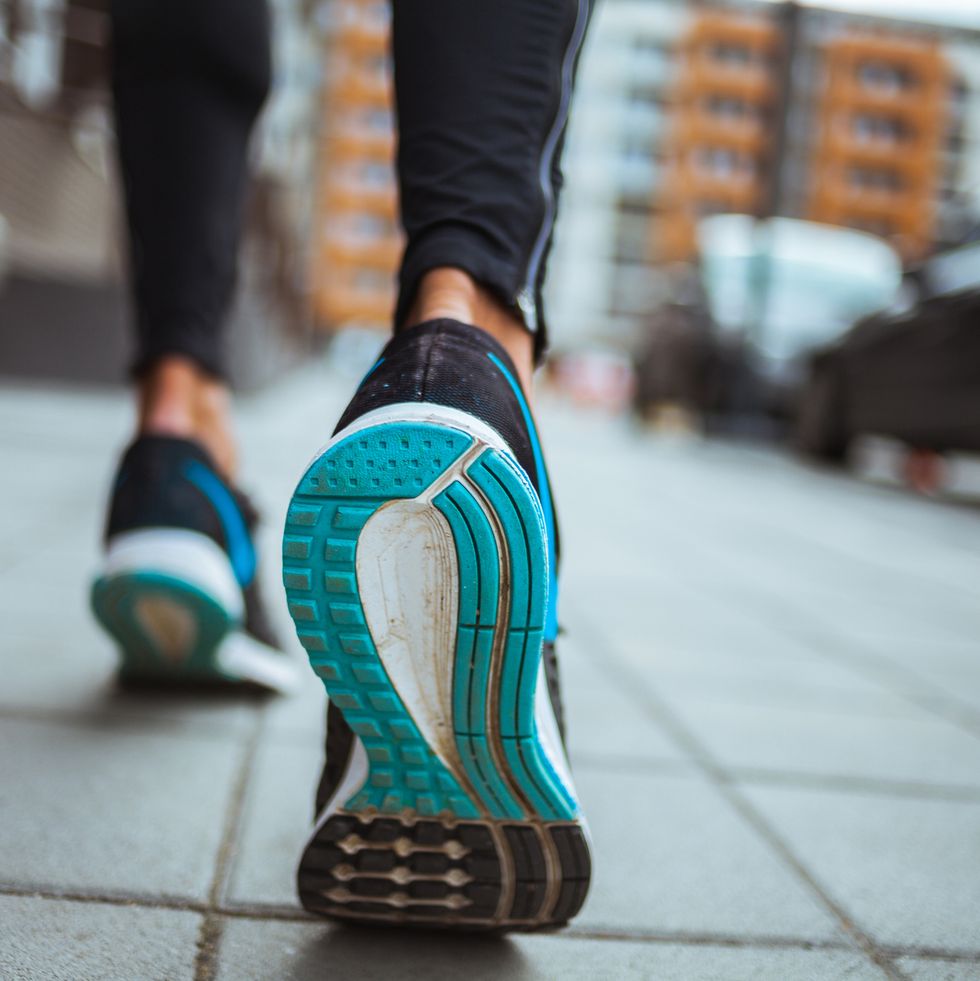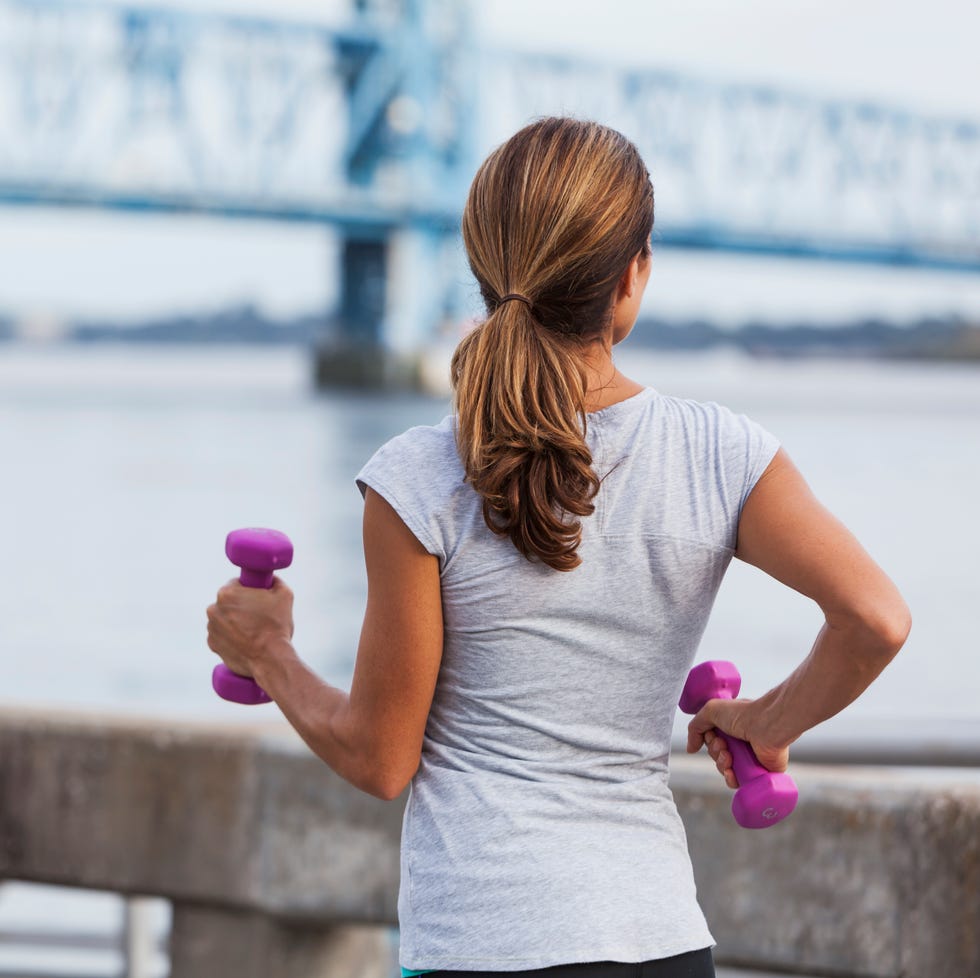25 Tips on How to Get Started | Fitness tips of the day

Walking is one of the easiest ways to get active, yet is often overlooked by those who are trying to break a sweat more often. Because more than 60% of Americans don’t get the recommended amount of exercise each week (with 25% of Americans not being active at all), per Centers for Disease Control and Prevention (CDC) data, starting to exercise may indeed feel painful and against the body’s tendency to stay sedentary. Walking is a great solution to this temporary hump: it’s simple, free to start and easier on your body’s joints.
In fact, many individuals successfully turn to walking as a useful weight management tool, and may even broach weight loss — especially when walking is combined with dietary efforts.
Research has long linked walking and weight loss, as walking effectively increases energy or calorie expenditure over time. Making walking a routine habit can optimize your resting metabolic rate by promoting an increase in lean body mass, too.
The benefits of walking go far beyond just the number on the scale. Research also suggests that walking routinely can reduce the risk of cardiovascular disease and also improve longevity. It can improve a person’s cognition while helping to decrease symptoms of anxiety and improve mood. Although there are pros and cons to walking at different times of the day, the best time of day to walk for weight loss is the time that works best in your schedule and one that you will stick to consistently.
Editor’s note: Weight loss, health and body image are complex subjects — before deciding to try a new fitness routine (or diet), we invite you to gain a broader perspective by reading our exploration into the hazards of diet culture.
Whether you’re walking for weight loss or just to improve your overall health, our expert tips are designed to help you get the most out of your walking session every day. Read on for our full list of tips and tricks after the FAQs below.
How much walking should I do if I am trying to lose weight?
There isn’t a one-size-fits-all plan when it comes to managing weight loss and physical activity, and the easiest way to know how much exercise is right for you is to speak with your healthcare provider. There are a lot of complex factors to consider when thinking about weight loss, including holistic nutrition intake and pre-existing medical conditions, which makes it near impossible for healthcare experts to be able to answer this question without knowing your precise medical history.
Generally speaking, however, established research backed by the American College of Sports Medicine suggests moderate physical activity — which includes walking, especially if you naturally break a sweat while doing so! — at 30 minutes five times a week can result in modest weight loss. The same evidence suggests that a more rigorous walking schedule of 250 minutes or more per week (just about 35 minutes a day) can result in clinically significant weight loss, often a goal for those with concurrent medical conditions like type 2 diabetes.
To safely approach walking for weight loss without risking injury or other complications, try easing into a moderate walking pace for 30 minutes a day, five days a week. You don’t have to head to the gym to do so; walk outside around your neighborhood, on paths in a public park or even along a nearby beach to get started.
Will I lose weight if I walk 30 minutes daily?
Just how much a person can realistically lose while walking is dependent on their diet, lifestyle and medical conditions at play, including your current weight and other physical activity — plus issues like stress, the environment you live in and even financial factors. While it’s true that walking can indeed help you burn calories, it can provide so many more holistic health benefits that can change your life, per materials published by the Mayo Clinic. These benefits include a boost to muscle endurance, improved balance, a boost in immunity, increased energy, improved mood, cognition, memory skills and even sleep — as well as reduced stress in the heat of the moment.
Health officials at the CDC have maintained that someone at a weight of 154lbs who walks at a moderate pace — which shakes out to be around 3.5mph — for at least 30 minutes a day can burn up to 140 calories. If you were to complete this routine five times a week, the calorie deficit could roughly equate to a pound a month. All to say; there is evidence suggesting that sticking to a routine walking habit can indeed help you make progress on your weight loss goals, especially when combined with other lifestyle efforts guided by your doctor.
If you’re curious about how walking may aid your efforts to target belly fat, several studies have indicated that a commitment to routinely walking may help reduce visceral fat (otherwise known as deep fat within the abdominal cavity) over time. Walking may also help to gradually reduce subcutaneous fat, located just beneath your skin, in your abdomen as well.
Easy ways to increase your walking step count every day
The best walking routines allow you to walk along uninterrupted for extended periods of time. But any amount of walking you do can lead to benefits discussed above; if you’re having trouble carving out time daily for a walk, try peppering it into an otherwise busy routine.
These are simple ways to increase how much you walk naturally throughout the day:
- Take the stairs instead of the elevator, or walk up the escalator instead of riding it.
- Schedule 10 minutes of walking in the morning, during the afternoon, and then again in the evening before bed.
- Deliberately get off at an earlier stop on public transport to incorporate more walking into your day.
- Park farther away from store, office and restaurant entrances instead of circling the lot for a closer spot.
- Ask a friend to join you for a walk-and-talk activity during a lunch break on nice days.
- Catch up with family or friends over the phone while walking outside as a way to keep company and entertained.
- Consider setting a timer to get up from your desk at work and taking a walk around your office a few times a day.
- Make plans in a nearby neighborhood and leave your car at home, if possible. Walking to and from activities is a great way to stay active.
- Shop in-person at grocery stores, perusing the aisles and carrying the groceries home by hand when possible.
25 tips to start walking for weight loss
1. Check the weather
Getting caught in a rainstorm in the middle of your walk isn’t exactly ideal. Take a look at the weather report in the morning to see when the best time for your walk would be. If you normally walk at around 5 p.m. but the weather report expects rain, then consider rescheduling your walk for lunchtime. And always carry a charged phone with you in case the weather takes a turn and you need someone to pick you up.
2. Hydrate
If you’re heading out for a long walk, make sure that you are hydrated and figure out how much water you should drink every day. Try to stay hydrated during the day and drink 2 cups of water at least 30-60 minutes before your walk so it’s out of your system and you won’t have to use the bathroom while you’re out. When you return from your walk, make sure to down a glass of water to rehydrate the body. Avoid any sugary sodas or electrolyte drinks; if you’re walking at a moderate intensity, water will do just fine to rehydrate the body.
3. Get the right gear
Toss away the old flip-flops and opt for your best walking shoes to add comfort to your stroll. This will help with your posture during your walk and can also reduce the risk of injury. Plus, if you have the right sneakers on, they can help improve your stride and make walking a longer distance more comfortable.
4. Wear layers
Dressing in layers can prove especially handy as your body warms up throughout your walk. Try a two- or three-layer system, with the first layer against your skin being a moisture-wicking workout top. Depending on the weather, a second and occasionally third layer can provide a barrier from the cold, wind, rain or all of the above. If you heat up, just tie that extra layer around your waist.
5. Invest in reflective clothing and accessories
If you frequently walk outside, reflective workout gear is essential for significantly increasing your visibility and keeping you safe. Whether you are walking during the day or in the evening, it can be hard for cars to see pedestrians at any time of day, so reflective gear and bright colors can make a big difference. Look for clothing and accessories like hats with reflective accents on both the front and back.
6. Focus on form
Walking itself doesn’t take much skill and is very natural, but certain posture and form cues can help enhance your walk. Focus on keeping your chin up and shoulders square. Your core should be activated and your back should be straight. Most importantly, your glutes should be engaged with every step; try to think about tucking your butt inward. You’ll want to land on your heels and roll forward to push off of your toes with each stride.
7. Pick up the pace
Walking in intervals is a great way to help you burn more calories and keep your walk interesting. When it comes to walking, there are three different paces:
- Stroll: Similar to window shopping, about a 3/4 difficulty on a scale of 10
- Brisk walking: Make a small effort here, about a 4/5 difficulty on a scale of 10
- Power walking: Moving with a purpose, about 5/6 difficulty on a scale of 10
Our experts recommend warming up with a stroll, then aiming for a brisk pace throughout your walk and pushing to a power walk pace every five minutes to get your heart rate up. See how long you can maintain a power walk pace and then try to increase it by a few seconds every time you go out for your walk. Power walking can make a big difference in your overall health.
8. Set a goal
How far can you walk in 30 minutes or in 1 hour? In order to optimize your walking pace, try to aim for 1.5 miles per 30 minutes and 3 miles per hour, which is a brisk pace of about 20 minutes per mile. If you can’t commit to walking for a full hour or 30 minutes, do what you can. Remember that anything is better than nothing when it comes to activity and even a short walk can tremendously contribute to your daily step count.
Our experts say it is also a good idea to set a goal for the number of walks you would like to reach per week and write them down so you can check off each walk as you go and feel a sense of accomplishment.
9. Walk on an incline
If you’re indoors, a treadmill will allow you to manipulate your incline which can enhance the caloric burn of your walk. If you’re outside, try to opt for a hilly area to optimize your walk. Research suggests that increasing the incline can enhance the intensity of the workout while also reducing the impact on the legs and joints. Plus, it activates many muscles throughout your body including your legs and core, while also increasing cardiovascular stamina and calorie burn.
10. Sprinkle in some reverse walking
Reverse walking, a fancy way to say walking backwards, may sound silly but it actually provides a variety of health benefits. It can help enhance body coordination and increase strength in leg muscles that are not as heavily used. A recent study even found that backwards walking reduced pain and improved physical function in individuals with knee osteoarthritis. Try doing a short burst of reverse walking a few times throughout your walk, just be sure to stay aware of your surroundings.
11. Try using light weights
Looking to level up your walks? Walking with light weights can be a great low-impact strength training exercise and intensify both calorie burn and muscle toning. You can try a weighted vest, ankle weights, wrist weights or light dumbbells that you hold throughout your walk. Even light 1- to 3-pound weights can get heavy quickly, so start with very light weights and a short walking route to test things out and see how your body feels.
12. Walk with a friend
An accountability buddy can help you stay on track and make that daily walk non-negotiable. Try to find a friend, family member or co-worker who will go for a walk with you a few times a week to keep you motivated and change things up. When you and your friend encourage each other, you may end up working harder. Plus, you’ll know someone else is counting on you to show up too.
13. Stroll with a furry loved one
Regular walking can work wonders for both you and your dog. Improved cardiovascular fitness, lower blood pressure, stronger muscles and decreased stress are some of the many benefits for humans. Walking is vital for your pet’s health too. Just like humans, it helps manage their weight and reduces the risk of medical complications like osteoarthritis, cardiovascular disease and more. Consider adding an extra 10 minutes to your regularly scheduled dog walk to ease into things for both you and your furry friend.
14. Walk for a cause
Apps like Charity Miles allow you to turn your steps into charity money. The app donates 25 cents to a charity of your choice for every mile you complete. Plus, you can create your own pledge page where friends can sponsor you, even if you’re not doing a marathon or race.
15. Find a motivating playlist
Create your own playlist or head to the Workout tab on Spotify for a variety of curated playlists to suit your workout preference. Choose from options like pumped pop, classic rock, heavy beats and more — opt for something upbeat and motivating! Research shows that walking to music may help you stick with it and also keep you walking at an effective stride rate.
16. Download a great audiobook
Take your favorite book outdoors by downloading a great audiobook to keep you busy during that afternoon stroll. Apps like Audible make your walks educational and can help pass the time while also keeping you engaged. If you’re looking for extra motivation to start your walk, a self-development audiobook may be just what you need to lace up and get moving.
17. Listen to your favorite podcast
Choose from one of our 50 best podcasts to keep you entertained on your daily walk. Whether you’re into true crime or celebrity interviews, this list is sure to have a podcast choice for everyone. A great podcast can help pass the time by and give you something to look forward to listening to, especially on those longer walks.
18. Find the right walking app for you
A walking app can be just the thing to keep you motivated and track your steps as you make note of your walking progress along the way. An app like Pacer is essentially a pedometer built into your smartphone, which is excellent for keeping track of your steps both on your walk and throughout the day. Alternatively, apps like 99 Walks provide a supportive community and guidance for walking and weight loss.
19. Walk around the world
Certain high-end treadmills offer beautiful scenic walking trails all around the world that you can enjoy from the comfort of your own home. Choose from destinations like Bali, Japan and more. Alternatively, you can take advantage of free walking tours on YouTube that go through destinations from Paris to Greece and more on your smartphone or tablet as you walk on the treadmill at home or at the gym.
20. Maximize your walk with a smartwatch
Investing in a smartwatch like the Fitbit Sense or Apple Watch can help upgrade your walking experience by providing enhanced stats, encouraging you to complete your steps for the day and keeping you hands-free while you stroll. Check out our best smartwatch picks to find one best suited to your needs.
21. Try an audio-based walking course
Our fitness experts love the on-demand audio-based walking classes on the Peloton Digital app. Seasoned instructors guide you through different walking intensities with curated playlists; it’s like walking with your very own personal trainer. Another great option that our pros recommend is Time to Walk, a feature on Apple Fitness+ where users can immerse themselves in a walk alongside influential and interesting people as they share meaningful stories, photos, music and more.
22. Stay safe
If you’re concerned about safety while out for your walk, apps like ROAD iD allow your friends and family to track you while you’re out on your route and offer other safety features. Always be aware of your surroundings and tell a friend or family member ahead of time where you are planning to walk and when you expect to be home.
23. Calculate your calorie burn
Calorie burn while on your walk can vary greatly depending on several factors like your weight, distance walked, incline, terrain and more. A smartwatch can help give you a fairly accurate estimate, but if you prefer not to use one then you can try estimating your burn with walking calorie calculators that are available for free.
24. Finish with a 5-minute stretch
Squeezing in even just five minutes of stretching after your walk can improve your range of motion and prevent injury. Move muscle recovery along by taking at least five minutes to do some static stretching, which involves moving a muscle or joint as far as it can go and then holding it for a period of time. Static stretches like a quadriceps stretch, hamstring stretch and tricep stretch are all examples that can help provide relief and relaxation of the muscles after your walk.
25. Consider building a walking plan for future walks
A structured walking plan can help hold you accountable and keep your walking routine interesting. Walk Your Way to Better Health, a walking plan from our sister magazine Prevention, comes with a preloaded MP3 player, dozens of walking workouts and 140+ healthy recipes to support your overall health. You can even map out a walking plan for yourself on your monthly calendar and find the best time of day that typically works for you to get moving during your schedule.
..
Nutrition Lab Director
Stefani (she/her) is a registered dietitian, a NASM-certified personal trainer and the director of the Good Housekeeping Institute Nutrition Lab, where she handles all nutrition-related content, testing and evaluation. She holds a bachelor’s degree in nutritional sciences from Pennsylvania State University and a master’s degree in clinical nutrition from NYU. She is also Good Housekeeping’s on-staff fitness and exercise expert. Stefani is dedicated to providing readers with evidence-based content to encourage informed food choices and healthy living. She is an avid CrossFitter and a passionate home cook who loves spending time with her big fit Greek family.
Joan Salge Blake, Ed.D., M.S., R.D.N., L.D.N., F.A.N.D. is a nutrition professor at Boston University and the host of Spot On!, the award-winning nutrition, health, and wellness podcast. She was awarded the prestigious Whitney Powers Excellence in Teaching Award from the university twice and the Academy of Nutrition & Dietetic Media Excellence Award. She has lectured at both the BU School of Medicine and BU Goldman School of Dental Medicine and is a sought-after speaker at conferences globally.
Joan is the author of Nutrition & You, Pearson (2023), Nutrition & You: Core Concepts to Good Health, Pearson (2010), and Eat Right The E.A.S.Y. Way, Prentice Hall Press (1991). She is the co-author of Nutrition: From Science to You, Pearson (2018).
Currently, she is a nutrition blogger for U.S. News & World Report’s Eat + Run Column. Joan has conducted over 2,500 interviews on numerous nutrition topics in media outlets such as the New York Times, Food Network, Newsweek, Washington Post, Forbes, Prevention, WebMD, Consumer Reports, MSNBC, Boston Globe, CBS-The Early Show, CNN, NBC News (Boston), CBS News (New York), Fox25 TV (Boston), and NPR.



























